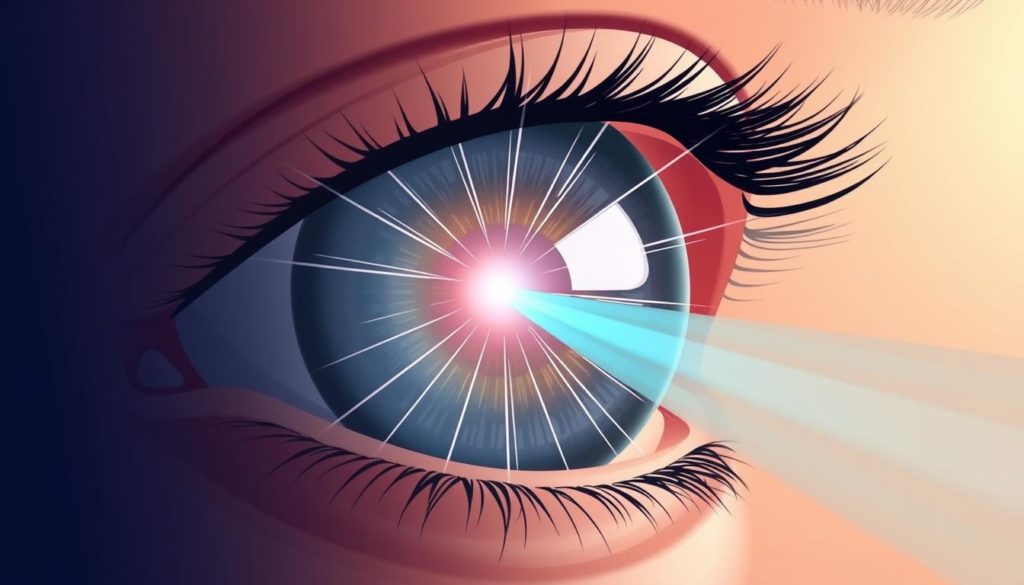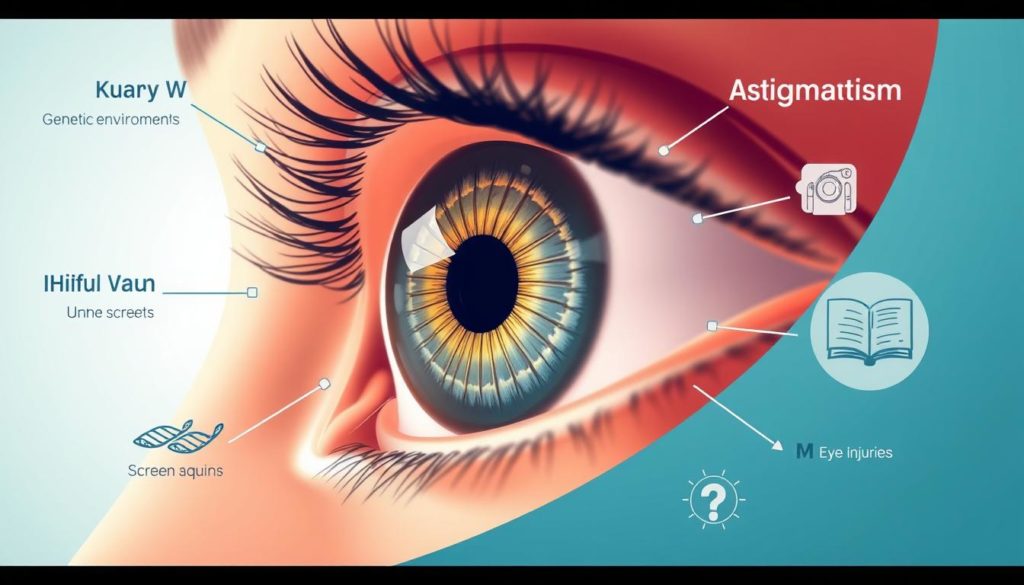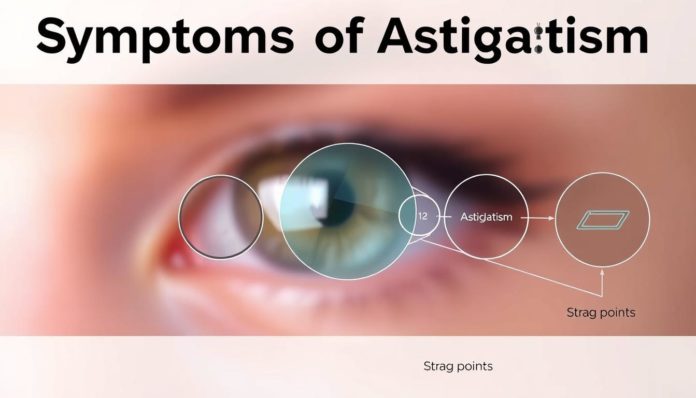Did you know that nearly 33% of Americans have some degree of astigmatism? This common eye condition can affect both children and adults. It often goes unnoticed until vision health starts to degrade. Early detection of astigmatism is crucial in preserving your eyesight and maintaining optimal vision health. In this article, we will take a comprehensive look at the signs and symptoms of astigmatism, making you more vigilant about detecting astigmatism early.
Recognizing the early eye condition signs can save you from a lifetime of compromised vision. Let’s dive into the various indicators of astigmatism and how they can impact your daily life.
What is Astigmatism?
Astigmatism is a common refractive error caused by an irregularly shaped cornea or lens. It makes it hard for the eye to focus light evenly on the retina. This results in blurry or distorted vision.

Definition and Explanation
Astigmatism is a refractive error that makes vision blurry. It happens when the eye can’t focus light evenly. This is because of problems with the corneal shape or lens.
Unlike myopia or hyperopia, astigmatism affects vision in all directions. It makes it hard to see both near and far objects clearly.
The Anatomy of the Eye
To understand astigmatism, knowing basic eye anatomy is key. The eye has several main parts: the cornea, lens, retina, and optic nerve. These parts work together to process visual information.
The cornea and lens bend light. If they’re not shaped right, light can’t focus on the retina. This causes a refractive error, leading to astigmatism.
In conclusion, knowing how eye anatomy relates to astigmatism helps us understand its impact on vision.
Common Causes of Astigmatism
Understanding astigmatism’s origins is key to managing it well. We’ll look at two main causes: genetics and environmental factors.
Genetic Factors
Genetics are a big part of astigmatism. Studies show that eye conditions passed down in families often lead to it. If a family member has astigmatism, you might get it too.
Research links certain genes to eye shape irregularities. This affects how well your eyes develop.

Environmental Influences
Genetics aren’t the only factor. Environmental factors also play a role. Long screen time, bad lighting, and near-work can change your eye shape.
Eye injuries or surgeries can also cause astigmatism. This shows how complex its causes are.
“Astigmatism isn’t just passed down. External factors also play a big part in its development. It’s a complex eye condition.” — Dr. Jane Smith, Ophthalmologist
Knowing both genetic and environmental factors helps manage eye health. Here’s a comparison of these influences:
| Genetic Factors | Environmental Influences |
|---|---|
| Family history of astigmatism | Prolonged screen time |
| Specific gene mutations | Poor lighting conditions |
| Inherited eye structure | Eye injury or surgery |
Blurred Vision: A Telltale Symptom
One of the most noticeable signs of Astigmatism is blurred vision. This symptom can make everyday activities hard because it affects visual clarity. Understanding how astigmatism changes your sight is important.
Understanding Blurred Vision
“Blurred vision” means our sight isn’t sharp, making things look out of focus. It can happen at any distance, making things like reading or seeing faces hard. Blurred vision might seem like eye strain, but it could be a sign of Astigmatism.
How Astigmatism Causes Blurred Vision
Astigmatism happens when the cornea or lens is shaped unevenly. This shape problem makes images distorted. When light doesn’t focus right on the retina, we see things blurred. This is because the eye can’t focus light evenly due to the shape issue.
Getting a proper diagnosis and treatment can greatly improve your visual clarity. Regular eye exams can catch astigmatism early. This leads to better symptom management and a better life.
Eye Discomfort and Strain
Astigmatism can cause eye strain, a common problem. This discomfort can affect your daily life. It’s important to understand how astigmatism relates to eye strain.
Eye strain happens when your eyes work hard to see clearly. This can lead to squinting, making things worse. Spotting these signs early can help avoid more problems.
People with astigmatism often face more eye discomfort. Their eyes struggle to focus light properly. This can cause irritation and more strain.
“Recognizing the signs of eye discomfort early can prevent the progression of strain-related issues,” says Dr. Susan Liang, an expert in optometry.
To ease eye discomfort, follow these tips:
- Make sure the room is well-lit when you read or work.
- Take breaks when you’re on the computer for a long time.
- Wear glasses that correct your astigmatism.
Headaches with Vision Changes
Having a headache with vision changes can be really annoying. It usually means there’s something wrong with your eyesight. Astigmatism is a common cause of these problems.
Why Astigmatism Leads to Headaches
Astigmatism makes your eyes work harder to focus, leading to eye fatigue. This constant effort can cause headaches. The irregular shape of your cornea or lens distorts light, making it hard for your eyes to process it.
Types of Headaches Caused by Astigmatism
Astigmatism can cause different kinds of headaches because of the eye strain. These include:
- Tension headaches: These are the most common. They feel like a dull ache around your eyes and temples.
- Migraines: Astigmatism can also cause migraines. These are more severe and can make you sensitive to light.
- Cluster headaches: These are rare but very painful. They affect one side of your head, often near your eye.
Fixing the astigmatism can help get rid of these headaches. Regular eye exams and the right glasses are key to managing eye fatigue from astigmatism.
Astigmatism Symptoms Overview
It’s important to spot vision problems early. Here’s a detailed astigmatism symptoms checklist to help you identify signs of this common issue:
- Blurred or distorted vision at any distance
- Frequent headaches, especially after visual tasks
- Eye discomfort or strain
- Difficulty seeing at night
- Squinting to see more clearly
- Double vision
With this astigmatism symptoms checklist, you can catch problems early. If you see these signs, get help from an eye doctor right away. Early detection and treatment can keep your eyes healthy and your vision clear.
Squinting: A Common Reaction
Squinting is a natural way many people try to see better when things are blurry. It changes the shape of the eye lens, helping to focus. But, it can also mean there’s a problem like astigmatism.
How Squinting Affects Vision
Squinting lets less light into the eye, making it easier to see. It helps clear up blurry images for a short time. But, squinting too much means you might need glasses or contacts.
Detecting Astigmatism Through Squinting
People with astigmatism often squint to see better. This habit can help doctors spot astigmatism early. If you or someone you know squints a lot, it’s time to see an eye doctor.
Early detection of astigmatism can lead to better treatments. This can prevent eye strain and discomfort in the long run.
Difficulty Seeing at Night
Do you find it hard to see after sunset? Many people with astigmatism face night vision problems. These issues are especially tough in dimly lit places, like during evening drives or at night.
Astigmatism changes how light enters your eye, causing blurry or distorted vision. This problem gets worse in low-light areas. At night, it can make lights appear as halos or glare, making it hard to see.
Seeing an ophthalmologist can help with these night vision issues. They might suggest a few things:
- Use anti-glare glasses: Special coatings can cut down glare from headlights.
- Adjust indoor lighting: The right amount of light can help with night vision.
- Regular eye check-ups: Keeping your prescription current can lessen astigmatism’s effects.
Understanding how astigmatism affects night vision is key. By tackling the astigmatism and making smart changes, you can feel safer and more comfortable at night.
| Aspect | Astigmatism Impact | Suggested Solution |
|---|---|---|
| Night Driving | Glare, halos around lights | Anti-glare glasses, frequent breaks |
| Reading in Low-Light | Blurry texts | Use reading lamps, increase font size |
| Outdoor Activities | Reduced sharpness | Bright headlamps, reflective gear |
Diagnosing Astigmatism
Spotting the signs of astigmatism early is key. An astigmatism diagnosis begins with detailed eye examinations. These tests check your eye health and find any irregularities in the cornea or lens.
These vision tests measure how well you see, how light bends, and if it focuses right on your retina.
Seeing an optometrist regularly is vital. They can spot astigmatism and watch for any changes in your vision. An optometrist might use different tools during these visits, like:
- Phoropters: Tools to find out your refractive error by trying different lenses.
- Keratometers: Devices to see if your cornea is shaped right.
- Corneal Topography: A way to map your cornea’s surface in 3D.
These tools help get a clear astigmatism diagnosis. This is important for treating and managing the condition. Regular optometrist consultations keep your eyes healthy and your vision clear.
Treating Astigmatism
There are many ways to treat astigmatism. Prescription lenses, like eyeglasses and contact lenses, are very common. They correct the irregular shape of the cornea or lens, giving you clear vision. Today’s eyewear is not only better for your eyes but also stylish and comfortable.
Refractive surgery is another option. LASIK and PRK have changed how we treat vision problems. These surgeries reshape the cornea to fix its shape, giving you better vision without glasses. Thanks to new technology, these surgeries are safer and more precise, making patients very happy.
It’s important to talk to an eye doctor to find the best treatment for you. You have many choices, from lenses to surgery. Experts say combining treatments with regular eye exams is key to keeping your eyes healthy and your vision sharp.
FAQ
What are the common symptoms of astigmatism?
Symptoms include blurred vision and eye discomfort. You might also get headaches, squint a lot, and struggle to see at night.
What causes astigmatism?
It can be due to genetics or environmental factors. These can shape the cornea or lens irregularly.
How does blurred vision relate to astigmatism?
Astigmatism makes the cornea or lens irregular. This distorts light rays, causing blurred vision.
Why does astigmatism lead to eye discomfort and strain?
The irregular shape forces the eye muscles to work harder. This leads to discomfort and strain.
How can astigmatism cause headaches?
Eye fatigue from focusing hard can cause headaches. This is especially true after doing visual tasks for a long time.
What is the significance of squinting in astigmatism?
Squinting is a natural way to try to see better. But doing it a lot can be a sign of astigmatism.
Why do people with astigmatism have difficulty seeing at night?
The irregular shape of the cornea or lens affects how light enters the eye. This makes it harder to see in low light, especially at night.
How is astigmatism diagnosed?
It’s diagnosed with a thorough eye exam. This includes vision tests and checks by an eye doctor.
What are the treatment options for astigmatism?
Treatments include glasses, contact lenses, and surgery. These options aim to correct the irregular shape of the cornea or lens.


